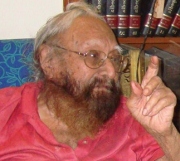With Malice Towards One and All he unleashed upon the world the Sardar in a lightbulb. Armed with a pen, aided by a weekly column and anecdotes to last a lifetime, Kushwant Singh was a man unafraid to say it all. However, after 70 years of fiery columns, the journalist has opted to recede into silence. The year was 1940, when Khushwant, bored with his life as a lawyer, picked up a pen and began writing and did not stop for another 70 years. His mind was exploding with ideas, his fingers were itching to grasp a pen and writing about people became his forte. Controversy was the inherent trait of every piece he produced, starting with the very first one. A rigid British loyalist, Sir Manohar Lal appeared on the pages of the Tribune, his character tailored around a minister unfortunate enough to have affronted Khushwant in the Punjab Legislative Council. Thus, a precedent was set and a legacy was born. Loved by his ardent following of readers, Khushwant’s innate talent was to brew a controversial storm in the unlikeliest of places. In the mid-1950s, when he took up the position of Editor Yojana, a journal that only published and publicised the five-year plans of the Indian government, he literally turned the journal around. For the first time in Indian journalism, he reserved an editorial page for himself, which instead of being Khushwant-Singh-centric was people-centric. It stirred a tempest and suddenly Indian journalism was transformed from a medium of robot-like reporting to a creatively enhanced, innovative medium that was widely anticipated and read. The widespread popularity of his column was due to the fact that his articles were about normal everyday life – something that his readers strongly related to. It was the piecing together of mundane ideas and day-to-day happenings, carefully blended in with juicy gossip and political drama, that informed his editorial masterpieces. From Yojana he periodically moved to editorial positions at several other magazines including, The Illustrated Weekly of India, The National Herald and the Hindustan Times, taking his celebrated column to each one. Due to the popularity of his column, The Illustrated Weekly was able to boast a circulation of 41,00,000. The columns were published into bestselling books a long time after they had first appeared in the newspapers. They were no longer just words printed on coarse paper that was discarded each week – it became an enduring entity in its own right. Authors clamoured for their books to be featured in his column; he was invited by filmmakers for private movie screenings; millions awaited his weekly sketches expertly drawn with words and many hated him for his guts. Khushwant may have retired as a columnist, but his mind may be playing with the idea of a book as his fingers once again twitch to hold a pen and begin writing.





